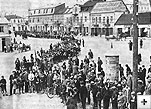



The Founding of the Jewish Community in Pinsk 1506-1700"The basic bill of rights" for the founding of a Jewish settlement was granted by the Pinsk Prince Jaroslavitch, on the 9th of August, 1506, and it included a permit for the construction of a synagogue and a graveyard. This settlement had an approximate population of 75 persons. After 150 years, on the eve of the "tach" and "tat" measures (1648) the community numbered 1,000 persons and this represented 20% of the overall Pinsk population. This community had legal civil rights and the freedom to pursue various economic sectors: trading, craftsmanship, loaning for interest, share cropping, taxes and tariffs collectors, exporting produce and forest products. By the end of October 1648, the town was occupied by Chmelnitski forces. Jews were murdered and fled and some were even baptized into Christianity (And they returned to Judaism after the tragedy). Towards the end of the 17th century, the Jewish settlement recovered. Hasidim and Mitnagdim in the 17thand 18th Century With the cancellation of the "Four-Country Committee" in 1764, the Pinsk Jewish settlement’s status was weakened. At this time, Pinsk and neighboring Karlin were penetrated by the Hassidic movement, and they remained in control of the community until 1750. Under pressure from R. Eliyahu, the Gaon of Vilna, the community leaders joined in an embargo against Hasidism. The Pinsk Rabbi , Rabbi Levi-Yitshak from Berdichew, stepped down, and in his place, a "Mitnaged" (Opposer), R. Avigdor Ben Yosef-Chaim was elected, but the Hasidic influence remained prevalent. The End of the 18thCentury and the 19th Century With the second division of Poland (1793), Pinsk was included under the Russian Kaiser’s rule. At this time there were 2,000 Jews living in the city. During the 19th century, the economic conditions improved. The Jews played an important role in the government’s efforts to turn Pinsk into a crossroads for commerce, primarily in the logging industry and in efforts to join southern Russia with ports along the Baltic sea via river transport. The city was full of Jewish merchants and craftsmen. In 1855, a Jewish agricultural settlement was founded in the adjoining village of Ivaniki. By the end of the 19th century, railway lines between Kiyov-Brisk were opened, and the line passed through Pinsk and this served as another catalyst for economic prosperity. Jews built industrial factories in the city: Plywood (Luria) Matches (Halperin), Flour milling, sawmills, passenger boats and others. Several thousand Jewish workers were employed in these factories, in addition to the hundreds of craftsmen from various occupations. With the advent of the material success, there was a rise in the educational movement. Alongside the traditional Jewish "Heder" or religious elementary schools, as well as a girl’s school along with the first vocational school in 1888. At the High School where Jewish students were taught in the Russian language, the first President of the State of Israel, Professor Chaim Weizmann received his education as a youth. He was a native of the neighboring town, Motol (Motele in Yiddish). He also participated in the activities of the "Union of the lovers of Zion". The First World War and the Polish GovernmentOn the eve of the First World War (1914), the number of Jews in the town reached 28,000 which translated into 72% of the city’s overall population. During the first few days of the Polish occupation of the city (April, 1919) 5 Nisan "Tarat", 35 of the Jewish community’s public leaders were summarily executed without trial, and with the sole accusation that they were Bolesheviks. Their bodies were secretly buried in the old cemetery on Zavalna Street. This event shocked the entire modern world, and the United States sent an investigative team to Pinsk lead by the Minister-Morgentau. The monument which should have been erected on this mass grave with the names of the victims who were murdered does not exist at this infamous sight. There is only a recreation of said monument at the memorial for the Pinsk Jewish community at Kibbutz Gvat near the monument sight for those who perished during the holocaust.
|




